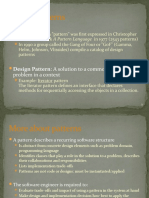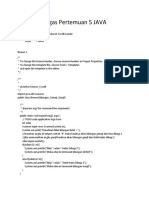0% found this document useful (0 votes)
45 views35 pagesLec18 Patterns 1
This document provides an overview of design patterns, including:
1. A design pattern is a standard solution to a common programming problem that improves flexibility, readability, and communication.
2. Examples of familiar patterns discussed are Observer and Iterator.
3. Reasons for using design patterns include fixing problems in underlying languages and increasing one's design vocabulary and tools.
Uploaded by
Anand BiradarCopyright
© © All Rights Reserved
We take content rights seriously. If you suspect this is your content, claim it here.
Available Formats
Download as PDF, TXT or read online on Scribd
0% found this document useful (0 votes)
45 views35 pagesLec18 Patterns 1
This document provides an overview of design patterns, including:
1. A design pattern is a standard solution to a common programming problem that improves flexibility, readability, and communication.
2. Examples of familiar patterns discussed are Observer and Iterator.
3. Reasons for using design patterns include fixing problems in underlying languages and increasing one's design vocabulary and tools.
Uploaded by
Anand BiradarCopyright
© © All Rights Reserved
We take content rights seriously. If you suspect this is your content, claim it here.
Available Formats
Download as PDF, TXT or read online on Scribd
/ 35
































































































